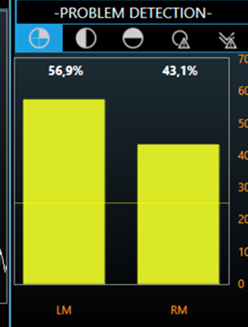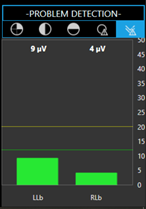Smartwear with sophisticated software enable merging complex laboratory EMG testing procedure into clinical setting, also for identifying factors behind low back pain (LBP).
An extensive scientific data shows consistently that superficial lumbar paraspinal muscular activity (EMG) is associated with nonspecific LBP as well as acute, subacute, and chronic LBP. Moreover, there is increasing evidence that lumbar EMG may reveal conditions that are predisposing to LBP and suggesting that when used for screening purposes, the onset of LBP may be prevented among those being in risk for the future pain.
There are several test conditions of how to utilize MBelt in clinical settings. These tests are valid, well known, and easy to apply, but their use has been limited so far due to complex measuring technology or observational judgement.
1. Flexion-relaxation-phenomenon test (FRP) - paraspinal muscle EMG level drops near resting level in trunk forward bending among normal condition. Among LBP subjects EMG level drop in forward bending is non-existent or weakened.

LBP Patient Healthy control
Pic by McGorry et al. Plos ONE, 2012

LBP screening test with MBelt3 in Muscle Monitor.
2. The symmetry index (SI) - muscular imbalance between right and left paraspinal muscles in forward bending.
Problem detection view in Muscle Monitor is showing left-right balance and relaxation. Traffic lights are indicating the deviations.
4. Trendelenburg testing - standing on one leg the waistline drops to the side of the opposite leg. Waistline drop is caused by weak gluteus medius and minimus muscles and therefore the compensatory EMG level increase is present in the contralateral paraspinal muscles. Myontec MBody shorts in combination with MBelt can show the muscle activation order and activation chain from lower back to gluteus muscles.

MBelt in primary prevention
Evidence suggests that asymmetrical activation pattern of the low back muscles is frequently mentioned as an important risk factor for the development of LBP problems among healthy workers and athletes. The FRP test can be positive even though there are no clinical signs of LBP present yet and it may enable to find a subgroup of subjects who would benefit from early preventive actions normalizing physical capacity and performance.
MBelt in secondary prevention
FRP is shown a promising method for individualizing rehabilitation treatment, decreasing unnecessary treatment, identifying potential post rehabilitation treatment outcomes and in validating long term functional impairment among LPB patients. Paraspinal muscle imbalance measured with the symmetry index and Trendelenburg testing would be informative tools in assessing recovery from LBP.
The MBelt measurement is fast to apply. The whole process from MBelt dressing, three test trials and data viewing can be completed in five minutes. Results are shown instantly in Myontec software and will be stored electronically to subject’s health records. MBelt can identify low back pain with objective numbers and visualize it in EMG profile. Applying this easy tool for clinical settings would improve health care cost-effectiveness, improve decision making and lead to reduced sick leaves due to low back problems.

References:
Cooper NA, Scavo KM, Strickland KJ, Tipayamongkol N, Nicholson JD, Bewywe D, Sluka KA. Prevalence f gluteus medius weakness in people with chronic low back pain compared to healthy controls. Eur Spine J 24:4; 1258-1265, 2016. doi: 10.1007/s00586-015-4027-6. Epub 2015 May 26.
Heydari A, Nargol AVF, Jones APC, Humprey AR, Greenough CG. EMG analysis of lumbar paraspinal muscles as a predictor of the risk of low-back pain. Eur Spine J 19:1145-1152, 2010.
Mayer TG, Neblett RMA, Brede E, Gatchel RJ. The quantified lumbar flexion-relaxation phenomenon is a useful measurement of improvement in a functional restoration program. Spine 34:22; 2458-2465, 2009.
McGorry RW, Lin J-H. Flexion relaxation and its relation to pain and function over the duration of a back pain episode. PLos ONE 2012 e39207. doi:10.1371/journal.pone.0039207
Moradi V, Memari A-H, ShayestehFar M, Kordi R. Low back pain in athletes is associated with general and sport specific risk factors: a comprehensive review of longitudinal studies. Rehabil Res Practice 2015. https://doi.org/10.1155/2015/850184
Murillo C, Martinez-Valdes E, Heneghan NR, Liew B, Rushton A, Sanderson A, Falla D. High-density electromyography provides new insights into the flexion relaxation phenomenon in individuals with low back pain. (2019) 9:15938 | https://doi.org/10.1038/s41598-019-52434-9
Paoletti M, Belli A, Palma L, Pierleoni P. Electromyography pattern likelihood analysis for flexion -relaxation phenomenon evaluation. Electronics 2020.; doi:10.3390/electronics9122046














Comentários